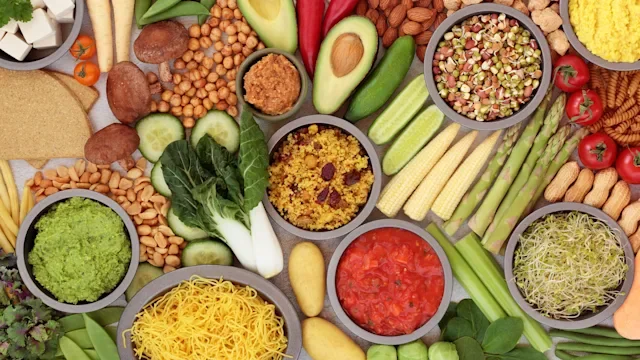Key takeaways:
Magnesium is a mineral found in nuts, grains, and beans. It’s easy to get enough magnesium because it’s in a wide variety of foods.
Some people may need to eat more high-magnesium foods to avoid deficiency. This includes older adults and people with Crohn’s disease, celiac disease, and Type 2 diabetes.
Healthcare professionals might recommend magnesium supplements to help with health conditions such as constipation or migraines.
Magnesium is involved in more than 300 different enzyme reactions that regulate different processes in your body. The main way to get magnesium is through the foods you eat. Your body can store it in your bones and soft tissues to make sure you have enough each day.
But half of the people in the U.S. don’t get enough magnesium from their diet. So, let’s take a look at which foods are a natural source of magnesium and talk about who might benefit from eating more of them.
What foods are high in magnesium?
Magnesium is found in many types of foods. If you follow a balanced diet with a variety of fruits, vegetables, and whole grains, you’re likely getting enough magnesium. Here is a list of the top 13 magnesium-rich foods.
1. Seeds, such as pumpkin and chia
Seeds are a great source of magnesium. They’re also packed with other nutrients like fiber and antioxidants. Fiber supports healthy digestion, blood sugar, and cholesterol levels. Antioxidants help protect your body’s cells from damage by fighting off free radicals, which would otherwise increase your risk for many chronic conditions. Some seeds, like flax and chia, also provide omega-3 fatty acids, which help fight inflammation.
2. Nuts, such as almonds and cashews
Nuts have many of the same health benefits as seeds. They contain healthy unsaturated fats, which help protect your heart. And they provide plant-based protein, which supports your bones, skin, and hormones. Protein can also help you find, and keep, a comfortable weight.
3. Leafy greens, including spinach and beet greens
Leafy greens are among the healthiest vegetables you can eat and many are high in magnesium. For example, 1 cup of boiled spinach provides 37% of your daily needs. Leafy greens also contain folate, which supports healthy blood and DNA production. And they have vitamin K, which helps with blood clotting.
4. Peanuts and peanut butter
Peanuts are actually legumes, not nuts. Just 1 oz of peanuts provides about 11% of your daily magnesium needs. The healthy fats, fiber, and vitamins in peanuts and peanut butter are excellent for heart health.
5. Fortified breakfast cereals
When you’re looking for a healthy cereal, choose ones that are low in added sugar, and high in fiber and protein. You might also want to check if the cereal is fortified with magnesium. This means magnesium was added during the production process. You’ll know it is if the box has a “fortified” label and if the ingredient list names magnesium.
6. Beans, such as black beans and kidney beans
Beans are a great source of fiber and plant-based protein. They’re also rich in folate and the mineral phosphorus, which supports bone health.
Magnesium and blood pressure: Most people don’t need a magnesium supplement, but there’s some evidence that it can help lower your blood pressure.
Should you take vitamin D and magnesium together? Vitamin D supplements can deplete your magnesium levels. Without enough magnesium, you can’t absorb vitamin D properly.
Magnesium deficiency: Learn about the symptoms, causes, and treatments for low magnesium.
7. Soy foods, including edamame, tofu, and soy milk
Magnesium is just one of the many nutrients in soy foods. Soy also has potassium, which supports muscle function and blood pressure levels. And it’s a good source of plant-based iron, which helps your blood deliver oxygen throughout your body. Eating foods made with soy may help protect against cancer, support weight management, and improve cholesterol.
8. Whole grains, like brown rice and oatmeal
Unlike refined grains, whole grains include all three parts of a grain: the germ, endosperm, and bran. The bran is the main source of many vitamins and minerals, including magnesium, iron, B vitamins, and fiber. Many whole grains, like quinoa, whole farro, and hulled barley, also contain protein.
9. Potatoes
Potatoes are a good source of magnesium. One medium-sized baked russet potato provides 12% of your daily needs. They’re also high in vitamin C, which supports a strong immune system and acts as an antioxidant. Potatoes are starchy vegetables and contain more carbohydrates than non-starchy vegetables. But they still provide fiber and are a nutritious addition to a balanced diet.
Read more like this
Explore these related articles, suggested for readers like you.
10. Dairy products, such as yogurt and milk
Many dairy foods are extremely nutrient-dense. In addition to magnesium, they contain calcium for strong bones, and zinc for your immune system. Milk is also one of the top dietary sources of potassium in the U.S. Some dairy products, like yogurt and kefir, contain probiotics, which support a healthy gut.
11. Bananas
Bananas may be best known for their potassium. But they provide almost just as much magnesium. Just one medium banana has 8% of your daily needs Bananas also have vitamin C, fiber, and B vitamins. Bananas are portable and nutrient-rich, making them one of the most popular fruits in the U.S.
12. Salmon
Salmon has a bit less magnesium than the plant foods on this list. But a 3-oz serving still provides 7% of your daily needs. Salmon also offers plenty of other nutrients, including omega-3 fatty acids, potassium, and phosphorus.
13. Avocados
In addition to their magnesium, avocados contain vitamins E and K, potassium, and healthy unsaturated fats. They’re also one of the fruits highest in protein. The nutrients in avocados support brain health, blood sugar management, and digestive support.
Here’s how much magnesium you can get from the following foods.
Food | Portion size | Magnesium (mg) |
|---|---|---|
1 oz | 156 mg | |
Chia seeds | 1 oz | 111 mg |
Almonds | 1 oz | 80 mg |
Boiled spinach | ½ cup | 78 mg |
Cashews | 1 oz | 74 mg |
Roasted peanuts | ¼ cup | 63 mg |
Fortified soy beverage | 1 cup | 61 mg |
Cooked black beans | ½ cup | 60 mg |
Edamame, shelled | ½ cup | 50 mg |
Peanut butter | 2 tbsp | 49 mg |
Baked potato with skin | 3.5 oz | 43 mg |
Brown rice | ½ cup | 42 mg |
Fortified breakfast cereal | 1 serving | 42 mg |
Plain yogurt | 8 oz | 42 mg |
Oatmeal, instant | 1 packet | 36 mg |
Kidney beans | ½ cup | 35 mg |
Bananas | 1 medium | 32 mg |
Salmon, cooked | 3 oz | 26 mg |
Milk, 1% | 1 cup | 24-27 mg |
Avocado | ½ cup | 22 mg |
Why is magnesium important?
Magnesium is a mineral that your body needs for many different functions. It’s particularly important for healthy nerve and muscle function. It also helps your body make new proteins, DNA, and even bone. These are just a few examples of its role in different processes.
Magnesium’s far-reaching effects help support:
Heart health: Magnesium helps regulate your heartbeat through its effects on nerve and muscle function. It also helps relax your blood vessels and may even help lower your blood pressure.
Blood sugar regulation: Magnesium helps your body make and use insulin. It also plays a role in glucose metabolism. This means it helps keep your blood sugar in a normal range, and may even help prevent Type 2 diabetes.
Bone strength: Your body is constantly breaking down and building new bone, and magnesium directly influences this process. It also plays a role in parathyroid hormone and vitamin D regulation, two other important ingredients for healthy bones.
Brain health: Since magnesium plays a key role in nerve function, it’s no surprise that it affects your brain in more ways than one. Low magnesium levels have been linked to inflammation in the brain, as well as mood disorders like anxiety and depression.
People take magnesium for a wide variety of health conditions, although some of these uses are more supported by research than others. People take it for:
Women’s health issues, such as premenstrual syndrome (PMS) and polycystic ovarian syndrome (PCOS)
Improved sleep
Magnesium recommended daily intake
Many people in the U.S. don’t get enough magnesium from their diet. The recommended dietary allowance (RDA) for magnesium depends on age and sex. Below is the RDA for adults.
Age | Male | Female | During pregnancy |
|---|---|---|---|
1-3 years | 80 mg/day | 80 mg/day | - |
4-8 years | 130 mg/day | 130 mg/day | - |
9-13 years | 240 mg/day | 240 mg/day | - |
14-18 years | 410 mg/day | 360 mg/day | 400 mg/day |
19-30 years | 400 mg/day | 310 mg/day | 250 mg/day |
31 years or more | 420 mg/day | 320 mg/day | 360 mg/day |
Who should eat foods high in magnesium?
Magnesium is important for everyone. But some people are more at risk for having a deficiency. If you fall into one of these groups, it’s especially important to include foods that are high in magnesium in your diet.
You might be at greater risk of magnesium deficiency if you:
Are an older adult: As we age, our ability to absorb magnesium is reduced. Low magnesium is linked to heart disease, high blood pressure, and stroke.
Take certain medications: Certain medications may cause low magnesium levels, such as proton pump inhibitors or diuretics.
Have a gastrointestinal (GI) condition: Your intestines may not absorb magnesium well if you have a GI condition such as Crohn’s or celiac disease.
Have Type 2 diabetes: Low magnesium levels are more common when blood sugar is frequently outside the normal range.
Drink a lot of alcohol: Alcohol can deplete your body of magnesium.
Magnesium deficiency can easily be tested with a blood sample. The normal range for magnesium is 1.7 mEq/L to 2.2 mEq/L.
What are the symptoms of a magnesium deficiency?
If you don’t get enough magnesium, you may have symptoms such as:
Poor appetite
Tiredness or weakness
Nausea or vomiting
Numbness or tingling
Muscle cramps
Abnormal heart rhythms (arrhythmias)
Seizures
Magnesium levels also impact other nutrient levels in your body. A severe magnesium deficiency can put you at risk for low levels of calcium or potassium.
Frequently asked questions
Most people get enough magnesium from food and don’t need to take a supplement. That said, many people take a magnesium supplement to help with health conditions like sleep or constipation.
If you’re considering a magnesium supplement, it’s always a good idea to clear this with your healthcare team first. Some people shouldn’t take a magnesium supplement, like those with kidney disease. Your healthcare team can make sure it’s safe for you and guide you in choosing the right type and dose based on why you’re taking it.
It’s not common to get too much magnesium from food. Your body typically flushes excess magnesium out in your urine. But it’s possible to get too much magnesium from supplements or medications, especially if you have abnormal kidney function. High levels of magnesium in your blood are dangerous and may cause dangerous drops in blood pressure and heart rate.
Certain nutrients can lower magnesium absorption. These include protein, phosphate, potassium, and zinc. Oxalate may also impair magnesium absorption. But the amount of these nutrients in a normal diet are unlikely to have a significant impact on your magnesium levels. Still, if you need magnesium supplements for a deficiency, it may be best to avoid taking them with the above substances.
Our bodies naturally use magnesium on a daily basis, which is why it’s important to incorporate it into your regular diet. Some things that can contribute to magnesium depletion include high alcohol intake, high calcium levels, and high blood sugar. Any condition that impairs intestinal absorption may also deplete magnesium. Dialysis, certain kidney conditions, and certain medications can also lower your magnesium levels.
Most people get enough magnesium from food and don’t need to take a supplement. That said, many people take a magnesium supplement to help with health conditions like sleep or constipation.
If you’re considering a magnesium supplement, it’s always a good idea to clear this with your healthcare team first. Some people shouldn’t take a magnesium supplement, like those with kidney disease. Your healthcare team can make sure it’s safe for you and guide you in choosing the right type and dose based on why you’re taking it.
It’s not common to get too much magnesium from food. Your body typically flushes excess magnesium out in your urine. But it’s possible to get too much magnesium from supplements or medications, especially if you have abnormal kidney function. High levels of magnesium in your blood are dangerous and may cause dangerous drops in blood pressure and heart rate.
Certain nutrients can lower magnesium absorption. These include protein, phosphate, potassium, and zinc. Oxalate may also impair magnesium absorption. But the amount of these nutrients in a normal diet are unlikely to have a significant impact on your magnesium levels. Still, if you need magnesium supplements for a deficiency, it may be best to avoid taking them with the above substances.
Our bodies naturally use magnesium on a daily basis, which is why it’s important to incorporate it into your regular diet. Some things that can contribute to magnesium depletion include high alcohol intake, high calcium levels, and high blood sugar. Any condition that impairs intestinal absorption may also deplete magnesium. Dialysis, certain kidney conditions, and certain medications can also lower your magnesium levels.
The bottom line
Magnesium is essential for maintaining your body’s immune defenses, keeping your bones strong, and ensuring your muscles are working properly. Since magnesium is found in many foods — like fruits, vegetables, and whole grains — it’s possible to get enough from your diet alone. A healthcare professional will likely only recommend a supplement if you’re low in magnesium.

Why trust our experts?



References
Barbagallo, M., et al. (2015). Magnesium and Type 2 diabetes. World Journal of Diabetes.
Barbagallo, M., et al. (2021). Magnesium in aging, health and diseases. Nutrients.
Food and Nutrition Service. (2024). Grain requirements in the CACFP: Questions and answers. U.S. Food and Drug Administration.
Gragossian, A., et al. (2023). Hypomagnesemia. StatPearls.
Kantor, L., et al. (2023). Apples and oranges are the top U.S. fruit choices. U.S. Department of Agriculture.
Larsson, S. C., et al. (2007). Magnesium intake and risk of Type 2 diabetes: A meta-analysis. Journal of Internal Medicine.
Maier, J. A. M., et al. (2022). Magnesium and the brain: A focus on neuroinflammation and neurodegeneration. International Journal of Molecular Sciences.
MedlinePlus. (2025). Magnesium in diet.
Młyniec, K. et al. (2014). Essential elements in depression and anxiety. Part I. Pharmacological Reports.
MyFoodData. (n.d.). Baked russet potatoes.
MyFoodData. (n.d.). Bananas.
MyFoodData. (n.d.). Cooked spinach (boiled, drained).
MyFoodData. (n.d.). Cooked wild Atlantic salmon.
MyFoodData. (n.d.). Raw peanuts.
Office of Dietary Supplements. (2021). Magnesium: Fact sheet for consumers. National Institutes of Health.
Office of Dietary Supplements. (2022). Magnesium: Fact sheet for health professionals. National Institutes of Health.
Office of Dietary Supplements. (2022). Potassium: Fact sheet for health professionals. National Institutes of Health.
Porri, D., et al. (2021). Effect of magnesium supplementation on women’s health and well-being. NFS Journal.
Swaminathan, R. (2003). Magnesium metabolism and its disorders. The Clinical Biochemist Reviews.
Schuchardt, J. P., et al. (2017). Intestinal absorption and factors influencing bioavailability of magnesium-an update. Current Nutrition and Food Science.
U.S. Department of Agriculture. (2019). Usual nutrient intake from food and beverages, by gender and age: What we eat in America, NHANES 2013-2016.
U.S. Food and Drug Administration. (2017). FDA drug safety communication: Low magnesium levels can be associated with long-term use of proton pump inhibitor drugs (PPIs).
Vatsalya, V., et al. (2020). Lower serum magnesium concentrations are associated with specific heavy drinking markers, pro-inflammatory response and early-stage alcohol-associated liver injury. Alcohol and Alcoholism.
















